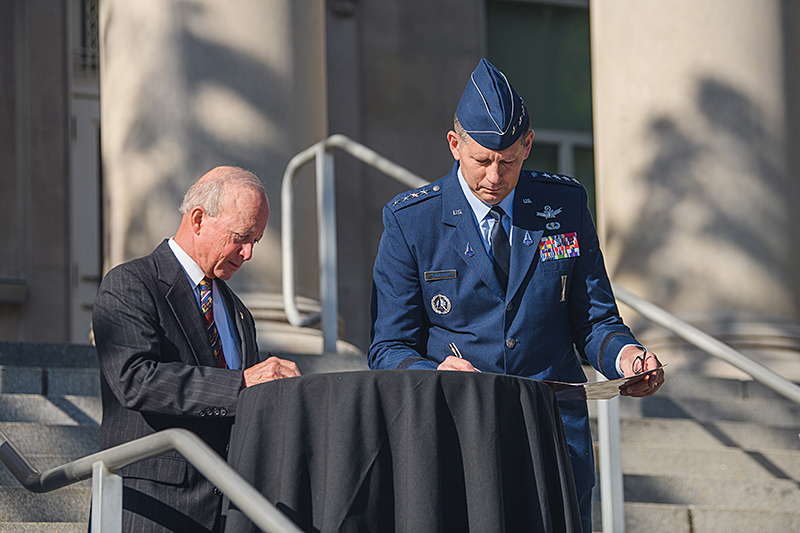September 29, 2021
Space Force, Purdue partner on STEM education, innovation

Purdue President Mitch Daniels and Gen. David D. “DT” Thompson, vice chief of space operations for the U.S. Space Force, sign an agreement making Purdue one of the founding members of the new Space Force University Partnership Program. (Purdue University photo/Rebecca McElhoe)
WEST LAFAYETTE, Ind. — Purdue University, known as the “Cradle of Astronauts,” established a new partnership with the U.S. Space Force on Wednesday (Sept. 29) to utilize university research, innovation and talent development as the latest member of the Space Force’s University Partnership Program.
Purdue President Mitch Daniels and Gen. David D. “DT” Thompson, USSF vice chief of space operations, signed a memorandum of agreement in Hovde Hall on the Purdue campus.
“For quite some time, Purdue’s involvement in space has expanded far beyond our distinguished history of astronauts,” Daniels said. “Our partnership with the Space Force provides yet another example of our commitment to space exploration and national security.”
The signing was part of a two-day campus visit for Thompson, who received his master’s degree in aeronautics and astronautics from the university in 1989. Thompson said the UPP will leverage the internationally renowned research and educational opportunities available at Purdue to take on the engineering, science and technology issues facing the Space Force.
“As someone who has personally benefited from the caliber of education Purdue provides, I am excited for the next generation of Guardians who will expand their knowledge and expertise through this partnership,” Thompson said. “Those Guardians must have the STEM foundation that provides a deep understanding of the space domain to conquer the challenges of today, coupled with the confidence and commitment to solve the problems we are certain to encounter in the future.”
While on campus, Thompson met with Air Force ROTC cadets training for Space Force, as well as officers in the Purdue Military Research Initiative.
Air Force Col. Ken Callahan, currently posted with Purdue’s Air Force ROTC detachment, said Purdue graduated several ROTC students directly to the Space Force last spring and recently welcomed several new Space Force military graduate students to campus.
“These students are just one an example of the quality of education we have at Purdue,” Callahan said. “People in the Air Force know about Purdue and its expanding connection to space and the Space Force program.”
Thompson also talked with university leaders, heard from faculty at Maurice J. Zucrow Labs and took driving tours of Purdue’s Discovery Park and the Aerospace District, a university-affiliated aerospace business hub for public and private research collaborations on research and commerce.
Purdue is one of 11 universities initially selected to join the UPP. Establishing strategic partnerships with this select set of nationally renowned universities allows the Space Force to recruit and educate a diverse, high-caliber workforce, offer opportunities to advance research in specific areas of interest, and develop a 21st-century, technology-savvy military service. Research is the largest component of the program, with Purdue and other universities each having its own research component.
Purdue was selected on criteria including the quality of STEM (science, technology, engineering and math) degree offerings and space-related research laboratories and initiatives; a robust ROTC program; a diverse student population; and degrees and programming designed to support military, veterans and their families in pursing higher education.
Following Wednesday’s signing, Purdue and the Space Force will begin working together to meet the program’s major goals, including establishing research assistantships, internship agreements, opportunities for Guardians to pursue advanced degrees and both ROTC and civilian scholarship programs.
Writer, Media contact: Brian Huchel, bhuchel@purdue.edu
Source: Mitch Daniels, president@purdue.edu
Note to journalists: Images and b-roll of the event are available via Google Drive. Journalists visiting campus should follow visitor health guidelines.

